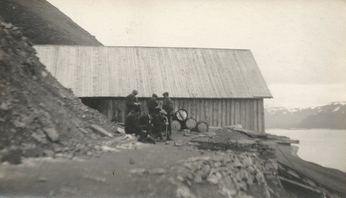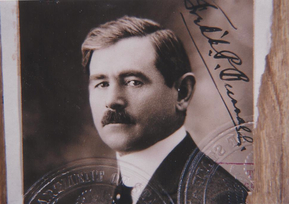by Jennifer Naze
 Longyear Valley & City - Photo from the Fred Tibbitts Collection
Longyear Valley & City - Photo from the Fred Tibbitts Collection Halfway between Norway and the North Pole lies a desolate island named Spitzbergen, which is the largest island in the Svalbard Arcepelago. The area was documented in Icelandic texts as early as 1194 c.e., but was not “officially” discovered until 1596 c.e. by Willem Barents. As Europeans began whaling and trapping in the 1600s, the discovered Svalbard became an area of intrigue. Explorers and scientists gave in to the curiosity of the desolate island to search for precious information. Two individuals that explored Spitzbergen were J.M. Longyear and Frederick Burrall.
J.M. Longyear was a businessman and land looker who believed in preserving natural resources while utilizing the properties the resources held. Mr. Longyear felt as if “there has always been a strong fascination for me in forest and wood life”, and perhaps this is the attitude that compelled him to set up a coal mining operation in the Arctic.
On July 14th, 1901 J.M. Longyear spotted the island and remarked, “it was a grandly desolate, sublime, weird landscape, utterly barren and unlike anything I had ever seen.” Mr. Ayer and Mr. Longyear began to develop the coal investment plan in 1905 and had William Munroe acting as supervisor on Spitzbergen. There were few coal mines that operated on the island, which was odd seeing as how the area had an abundance of coal that sometimes would lay on the surface. Coal shipments started in 1907.
In 1908, Mr. Frederick P. Burrall was named the general manager of the Arctic Coal Company. Mr. Burrall kept a diary and took photographs of his travels from the United States to the mining operation in Spitzbergen. While traveling on the S.S. William Munroe, Fred Burrall took photographs of seals, whales, polar bears and icebergs that hindered water travel. Mr. Burrall documented how many tons of coal would be loaded onto ships and calculate the cost per boatload. There were days where Mr. Burrall would be stuck at the office doing paperwork because of heavy storms and often documented these days in his diary. Not all of Fred Burrall’s diary entries pertained to business. On July 11th, 1909 a 4th of July celebration was held at Spitzbergen. There were foot races, potato races and many other festive activities. When Mr. Burrall was back in the United States, he would write about nights at the theatre with Mr. and Mrs. Longyear.
J.M. Longyear was a businessman and land looker who believed in preserving natural resources while utilizing the properties the resources held. Mr. Longyear felt as if “there has always been a strong fascination for me in forest and wood life”, and perhaps this is the attitude that compelled him to set up a coal mining operation in the Arctic.
On July 14th, 1901 J.M. Longyear spotted the island and remarked, “it was a grandly desolate, sublime, weird landscape, utterly barren and unlike anything I had ever seen.” Mr. Ayer and Mr. Longyear began to develop the coal investment plan in 1905 and had William Munroe acting as supervisor on Spitzbergen. There were few coal mines that operated on the island, which was odd seeing as how the area had an abundance of coal that sometimes would lay on the surface. Coal shipments started in 1907.
In 1908, Mr. Frederick P. Burrall was named the general manager of the Arctic Coal Company. Mr. Burrall kept a diary and took photographs of his travels from the United States to the mining operation in Spitzbergen. While traveling on the S.S. William Munroe, Fred Burrall took photographs of seals, whales, polar bears and icebergs that hindered water travel. Mr. Burrall documented how many tons of coal would be loaded onto ships and calculate the cost per boatload. There were days where Mr. Burrall would be stuck at the office doing paperwork because of heavy storms and often documented these days in his diary. Not all of Fred Burrall’s diary entries pertained to business. On July 11th, 1909 a 4th of July celebration was held at Spitzbergen. There were foot races, potato races and many other festive activities. When Mr. Burrall was back in the United States, he would write about nights at the theatre with Mr. and Mrs. Longyear.

 RSS Feed
RSS Feed